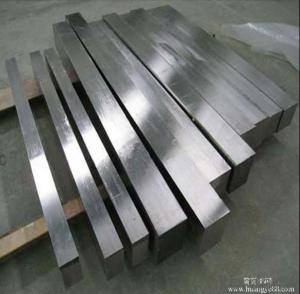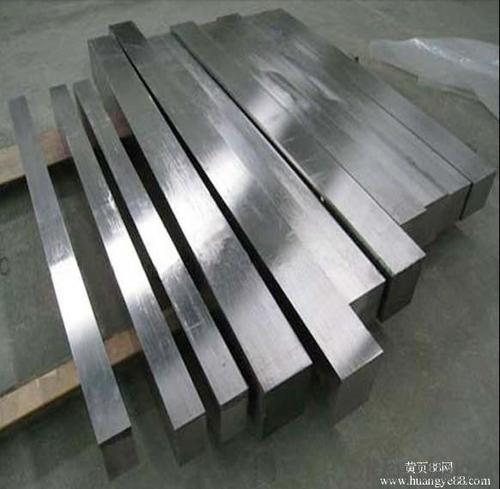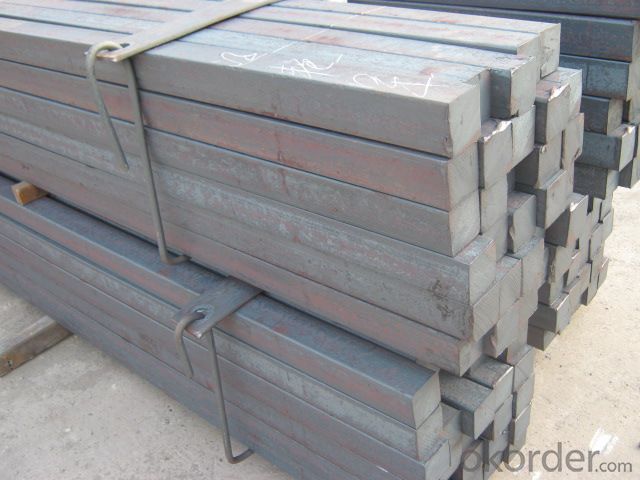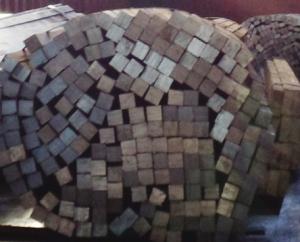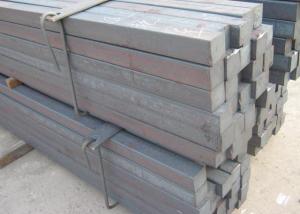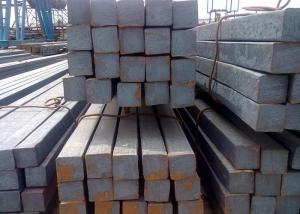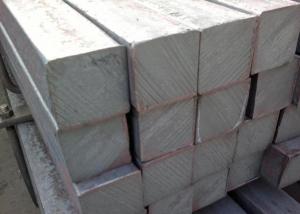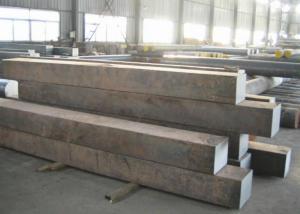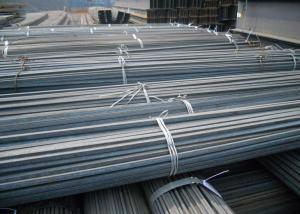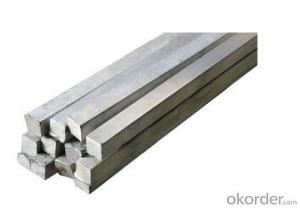high quality square steel bar
- Loading Port:
- China Main Port
- Payment Terms:
- TT OR LC
- Min Order Qty:
- -
- Supply Capability:
- -
OKorder Service Pledge
OKorder Financial Service
You Might Also Like
Product Description:
We offer Square Steel Bar with grade Q195 / Q235
Specifications of Square Steel Bar:
-Standard: GB,
-Grade: Q195/Q235 or equivalent.
Chemical Composition:
-Chemical Composition. Q195
Standard | Grade | Element (%) | ||||
GB | Q195 | C | Mn | S | P | Si |
0.06~0.12 | 0.25~0.50 | ≤0.050 | ≤0.045 | ≤0.30 | ||
-Chemical Composition. Q235
Standard | Grade | Element (%) | ||||
GB | Q235B | C | Mn | S | P | Si |
0.12~0.20 | 0.30~0.70 | ≤0.045 | ≤0.045 | ≤0.30 | ||
Measures and Tolerances of Square Steel Bar:
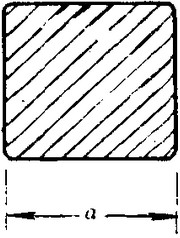
(The section of Square Steel Bar)
-The length of a side and the theoretical weight of Square Steel.
Length of a side(a, mm) | Theoretical weight(kg/m) | Length of a side(a, mm) | Theoretical weight(kg/m) |
6 | 0.283 | 32 | 8.04 |
7 | 0.385 | *33 | 8.55 |
8 | 0.502 | 34 | 9.07 |
9 | 0.636 | *35 | 9.62 |
10 | 0.785 | 36 | 10.17 |
11 | 0.950 | 38 | 11.24 |
12 | 1.13 | 40 | 12.56 |
13 | 1.33 | 42 | 13.85 |
14 | 1.54 | 45 | 15.90 |
15 | 1.77 | 48 | 18.09 |
16 | 2.01 | 50 | 19.63 |
17 | 2.27 | 53 | 22.05 |
18 | 2.54 | *55 | 23.6 |
19 | 2.82 | 56 | 24.61 |
20 | 3.14 | *58 | 26.4 |
21 | 3.46 | 60 | 28.26 |
22 | 3.80 | 63 | 31.16 |
*23 | 4.15 | *65 | 33.17 |
24 | 4.52 | *68 | 36.3 |
25 | 4.91 | 79 | 38.49 |
26 | 5.30 | 75 | 44.16 |
*27 | 5.72 | 80 | 50.24 |
28 | 6.15 | 85 | 56.72 |
*29 | 6.60 | 90 | 63.59 |
30 | 7.06 | 95 | 70.85 |
*31 | 7.54 | 100 | 78.50 |
Notes:
1, The theoretical weights in the list, base on the density of 7.85 g/cm3.
2, The numbers with *mean that they are not regulars or we don’t offer them.
-The allowed tolerance of Square Steel:
Length of a side(mm) | Allowed Tolerance | ||
Group1 | Group2 | Group3 | |
5.5~7 | ±0.20 | ±0.30 | ±0.40 |
7~20 | ±0.25 | ±0.35 | ±0.40 |
20~30 | ±0.30 | ±0.40 | ±0.50 |
30~50 | ±0.40 | ±0.50 | ±0.60 |
60~80 | ±0.60 | ±0.70 | ±0.80 |
80~110 | ±0.90 | ±1.0 | ±1.1 |
110~150 | ±1.2 | ±1.3 | ±1.1 |
150~190 | ―― | ―― | ±2.0 |
190~250 | ―― | ―― | ±2.5 |
Usage/Applications of Steel Square Bar:
-The Square Steel is normally used as structure steel.
-Row material for other structure steel like steel angles, channels, I-beams, H-beams, etc…
Packaging & Delivery of Steel Square Bar:
-Packing Detail: The products can be packed in bundles by steel wires.
-Marks:
1, Tag marks: the tag marks will be tied up to each bundle of the products. The information is usually including supplier’s logo and name, product name, made in China, products’ specifications, the painted color and other information requested by customers.
2, Color marks: we will paint both ends of the bundles of these products to make sure that they are more evident. It’s will be more convenient for the customers to distinguish them at the destination port.
-Delivery Detail: 30~45 working days after receive buyer’s T.T. or L/C.
Transportation:
-The products can be delivered by bulk vessel or by container. As for container, products with the length of 6m will be loaded in 20’ container, with 9m or 12m, in 40’ container.
-The maximum quantity of loading of container is 25 tons.
-The products usually are transported to the nearest port from the production place.
Payment:
-Invoicing on theoretical weight or actual weight a s customer’s request.
-FOB, CFR or CIF.
-Regular terms of payment:
1, 30% payment in advance, the remaining balance (70% payment) against the copy of B/L.
2, 30% payment in advance, the remaining balance (70% L/C) against the copy of B/L.
3, Negotiable.
- Q: The working principle of steel punching machine
- 2, two dimensional coordinates can be stopped at the same time manual conditioning, high and low speed movement, relative zero programming, automatic back zero, two axis linkage;3 directly input digital programming, use panel or remote stop control4, stable quality, reliable performance, cumbersome operation, safe and efficient.
- Q: How do you use a steel square to measure the width of a door jamb?
- To measure the width of a door jamb using a steel square, follow the instructions below: 1. Make sure you have a steel square that consists of a long blade and a shorter tongue perpendicular to each other. This type of square is commonly referred to as a framing square or carpenter's square. 2. Begin by positioning the steel square against the inner edge of the door jamb. Ensure that the long blade is touching the floor and the tongue is facing towards the door opening. 3. Adjust the square by sliding it until the long blade is flush against one side of the door jamb. It is important to hold the square firmly and maintain a level position. 4. Examine the measurement markings on the long blade of the square. The numbers on the blade indicate inches or centimeters. Locate the mark that aligns with the opposite side of the door jamb. This mark will provide the width measurement of the door jamb. 5. Take note of the measurement obtained and repeat the process on the other side of the door jamb to ensure accuracy. If the door jamb is not perfectly square, take multiple measurements at different points along the jamb and calculate the average width. By following these steps, you can effectively utilize a steel square to measure the width of a door jamb. It is crucial to have a steady hand and maintain a level square in order to obtain accurate measurements.
- Q: How do you use a steel square to mark out 75-degree angles?
- To use a steel square to mark out 75-degree angles, you would typically follow these steps: 1. Place the steel square on a flat surface or workpiece, ensuring that the long side of the square is parallel to the edge you want to mark the angle on. 2. Align one edge of the square with the desired starting point of the angle. This edge will serve as the reference line for marking the angle. 3. Locate the 45-degree angle line on the steel square. This line is usually marked with a number or a symbol. 4. From the reference line, measure in the direction of the angle you want to mark, counting inwards along the 45-degree angle line. In this case, measure 30 degrees inwards along the 45-degree line. 5. Once you have measured the appropriate distance, make a mark at that point. This mark indicates the starting point of the 75-degree angle. 6. From the starting point, measure an additional 75 degrees in the desired direction, using the appropriate scale on the steel square. This could be the 90-degree line or a specific angle scale marked on the square. 7. Make a second mark at the endpoint of the 75-degree angle, completing the marking process. Remember to double-check your measurements and use a sharp pencil or marker to ensure accurate and visible markings. Additionally, practice using the steel square on scrap material before marking your final workpiece to ensure precision.
- Q: The joiner board is fixed on the square on how
- With self tapping screws, that is, with drill screws, building materials market can buy. Electric screwdriver, you can put the wood board through self tapping screws into the steel. But attention should be paid to buy the self tapping screw length, short patch does not live too long into the square, too much is not good.
- Q: How do you use a steel square to lay out a pentagon?
- In order to lay out a pentagon using a steel square, a specific set of steps must be followed. Below is a guide to assist you in this process: To begin, you must determine the desired size of the pentagon. It is necessary to know either the length of one side or the apothem (the distance from the center to any side). Next, place your steel square on a flat surface, ensuring proper alignment. Measure the desired length of one side of the pentagon on the blade of the steel square. Use a pencil or any suitable marking tool to mark this measurement. Position the blade of the square at the desired starting point for the construction of the pentagon. Make sure that the marked measurement aligns precisely with the starting point. Hold the steel square securely in place and pivot it around the starting point, creating an arc. Repeat the previous step by pivoting the square around the endpoint of the arc, creating another arc that intersects the first one. Continue this process, pivoting the square along the intersecting arcs, until you have five intersecting arcs. Connect the points where the arcs intersect to form the sides of the pentagon. Once the sides of the pentagon are marked, double-check the angles to ensure that they all measure 108 degrees. Make any necessary adjustments. Finally, use a ruler or straight edge to connect the marked points, thus forming the complete pentagon shape. The process of using a steel square to lay out a pentagon demands precision and meticulous measurements. By following these steps, you will be able to construct a pentagon accurately using this versatile tool.
- Q: How do you use a steel square to determine the width of a board?
- To use a steel square to determine the width of a board, there are a few simple steps to follow. First, ensure that the steel square is clean and free from any debris or rust. This will help ensure accurate measurements. Next, place the steel square against one side of the board, aligning it so that one edge of the square is flush against the edge of the board. Hold the square firmly in place and look at the markings on the square. The steel square typically has measurements marked in inches on one side and in centimeters on the other side. Find the marking on the square that corresponds to the width you are trying to determine. For example, if you want to find the width of the board in inches, locate the appropriate inch marking on the square. Once you have located the correct marking, look at the opposite side of the square where it meets the other edge of the board. This point will indicate the width of the board. Take note of the measurement and record it if necessary. Repeat this process on different sections of the board to ensure accuracy, as boards can sometimes have slight variations in width. By using a steel square in this way, you can easily determine the width of a board with precision and accuracy.
- Q: Can a steel square be used for checking the alignment of a table saw fence?
- Yes, a steel square can be used for checking the alignment of a table saw fence. The straight edges of a steel square can be placed against the table saw fence and the table surface to ensure that they are parallel.
- Q: Can a steel square be used for gazebo post layout and installation?
- Indeed, gazebo post layout and installation can benefit greatly from the utilization of a steel square. A steel square, commonly referred to as a framing square or carpenter's square, is a versatile tool frequently employed in the domains of construction and woodworking. Comprised of a lengthy blade and a shorter tongue that intersect at a 90-degree angle, this tool enables precise measurements and layout. When it comes to gazebo post layout and installation, the value of a steel square cannot be overstated. It facilitates the determination of accurate angles and measurements required for the positioning of the posts, ensuring their proper alignment and levelness. To employ a steel square for gazebo post layout, one can utilize it to mark the corners and angles where the posts ought to be placed. By aligning either the blade or the tongue of the square with the edges of the gazebo base or the desired location of the posts, one can guarantee precise measurements and angles. Additionally, during the installation process, a steel square proves to be quite useful for verifying the plumbness and levelness of the posts. By positioning the square against the sides of the posts, one can ascertain whether they are perfectly vertical or if adjustments need to be made. In conclusion, a steel square is undeniably suitable for gazebo post layout and installation. Its versatility and accuracy render it an invaluable tool for ensuring the accurate positioning and levelness of the posts.
- Q: Can a steel square be used for checking the flatness of a ceiling?
- No, a steel square cannot be used for checking the flatness of a ceiling. A steel square is primarily used in woodworking and metalworking to measure and mark right angles. It is not designed or suitable for checking the flatness of large surfaces such as ceilings. For checking the flatness of a ceiling, other tools like a straightedge or a laser level would be more appropriate.
- Q: How do you use a steel square to determine the correct angle for a bevel cut?
- To use a steel square to determine the correct angle for a bevel cut, you align the long edge of the square with the edge of the material you want to cut. Then, you adjust the square until the desired angle is achieved. Once the square is in position, you can mark the angle on the material to guide your bevel cut.
Send your message to us
high quality square steel bar
- Loading Port:
- China Main Port
- Payment Terms:
- TT OR LC
- Min Order Qty:
- -
- Supply Capability:
- -
OKorder Service Pledge
OKorder Financial Service
Similar products
Hot products
Hot Searches
Related keywords
